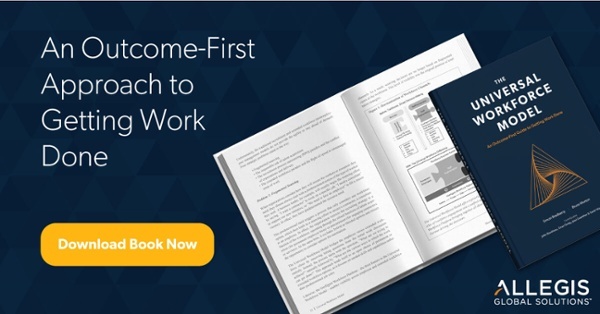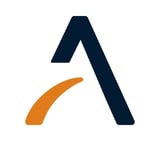What is the Universal Workforce Model?
The Universal Workforce Model™ is a results-first approach to getting work done. By viewing your workforce model by the tasks that need to be completed and the skills that are required, instead of only searching for roles to be filled, your organization can assess the needs of the company and the work that needs to be done, then build out the individuals who can ensure those needs are met.
As you read further, you will have a better understanding of the following:
- Why now is the time to start the journey based on converging business trends
- What the Universal Workforce Model is and what its three core elements are
- Which stakeholders benefit from this approach to workforce modeling
Why is Now the Time for the Universal Workforce Model?
Emerging from the pandemic, companies face more pressure than ever to adjust to a changing workforce. The primary goal of this framework is to implement the most efficient and effective way to get work done. Remote work, in-demand skills, rebuilding teams, evolving the organization – every aspect of the business is subject to a complete rethink and redesign.
Successful companies will be the ones that can answer the question, “Is it best for us to utilize a current employee, hire someone, outsource the work, use a contractor or consultant, use an on-demand talent platform, automate part or all of the task or combine several of these options?” How should we evolve our workforce planning model?
Departing From “Status Quo Innovation”
To arrive at an answer, organizations must transform how they view work and make workforce decisions. One vision that has attempted that transformation is the “total talent” or “integrated talent” strategy.
That approach focuses on bringing together previously siloed functions of HR (associated with hiring employees) and procurement (related to a contingent workforce strategy that engages suppliers and services providers). As a result, companies would no longer make employee-versus-contractor decisions in a vacuum because every worker type is in the conversation.
Unfortunately, the total talent approach is full of challenges. First, what is total talent? If an organization has coordinated permanent and contingent worker strategies, does that count? What if consultant engagements are considered separately? Second, the means to pool data from disparate systems was not widely available until recently. Finally, total talent provides little direction on what happens once companies achieve the data visibility they seek. While the concept expands an organization’s options for targeting workers, it does not directly address who should do the work or how work gets done.
How Do You Create a Universal Workforce Planning Model?
Enter a fundamentally different approach to your workforce management strategy. The new model approaches work and the workforce from an entirely new first step: Start with the results.
The Universal Workforce Model is an outcome-first business strategy approach that accounts for the complete workforce view afforded by technology today. This model puts employees, prospective employees, contractors and services providers into a common framework for deciding how work gets done. It provides a single business partner function dedicated to identifying paths for using the best available resource for the task and aligning workforce strategy to business outcomes.
And most importantly, the model starts by deconstructing the work needed to achieve an outcome into its component tasks. Then it is possible to rethink who does those tasks and how they are accomplished. By rebuilding the path to the outcome, planners can disconnect workforce expectations from legacy definitions of who does what work.
“As a result, the model empowers organizations to apply resources and achieve outcomes with the flexibility, creativity and efficiency essential to a world of rapid change.”
Defining the Universal Workforce Model
A universal approach to the workforce will require transformational changes in certain aspects of the business. It is a journey that will involve time and commitment; however, getting started is easy and will yield near-term benefits along the way. To best understand how we get there, let’s start with the Universal Workforce Model’s definition and then look at its impact on the business.
Current models, such as in-house or outsourced talent acquisition, contingent workforce management or managed service provider (MSP), are resource-defined, meaning that the first step in the process is to ask, “Whom do you want to hire?”
Unlike current and legacy models, an outcome-first approach starts with the question, “What are we trying to achieve?” It then provides a mechanism to focus on identifying the optimal path and resource for the outcome being sought.
Our model harmonizes currently siloed resource channels (including employees, contingent workers, services providers and automation), advocates tasks above roles and uses technology to ensure data-led decision-making.
The Universal Workforce Model has three defining features based on classic areas of business transformation: process, people and technology:
- Task-Based Versus Role-Based Planning (Process): An operating system built on deconstructed jobs promotes organizational agility. The business is asked, “What do you need to achieve?” and not “Who do you want to hire?” As a result, it is easier to assess workforce options objectively, identify automation opportunities and deliver a resourcing process aligned to diversity, equity and inclusion (DEI) goals.
- Workforce Business Partner (People): As a single point of contact for accessing all workforce channels for a business unit, the workforce business partner applies a task-based approach to planning resources and activity to achieve an outcome. The partner uses comprehensive external market and internal data to advise the business on the ideal way to get work done and deliver the best approach to accessing the entire workforce.
- An Intelligent Workforce Platform (Technology): The workforce business partner is empowered by an AI-driven technology platform. As a source of data-driven intelligence, the Intelligent Workforce Platform gives visibility into an organization’s entire employed and extended workforce. It also provides a gateway to complementary technologies, enabling objective, evidence-based decisions.
We hope this article provides a basis for understanding the Universal Workforce Model. Still, it may raise more questions than it answers. And it should! Naturally, one should question what task-based planning looks like, how an organization finds or develops a workforce business partner and how the Intelligent Workforce Platform differs from past technology innovations.
**Editor’s Note: This article was originally published in “The Universal Workforce Model: An Outcome First Guide to Getting Work Done.”
-min.png)





